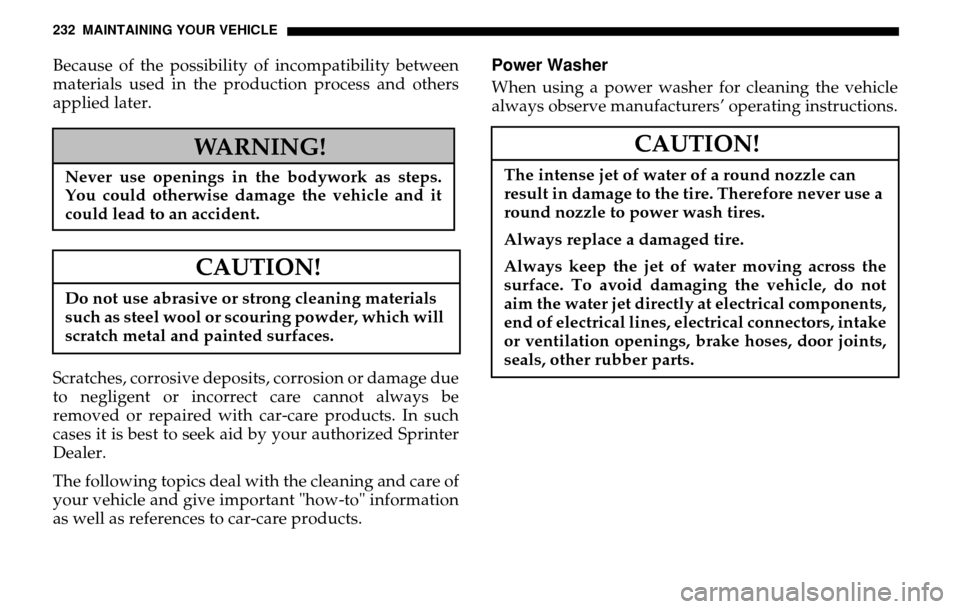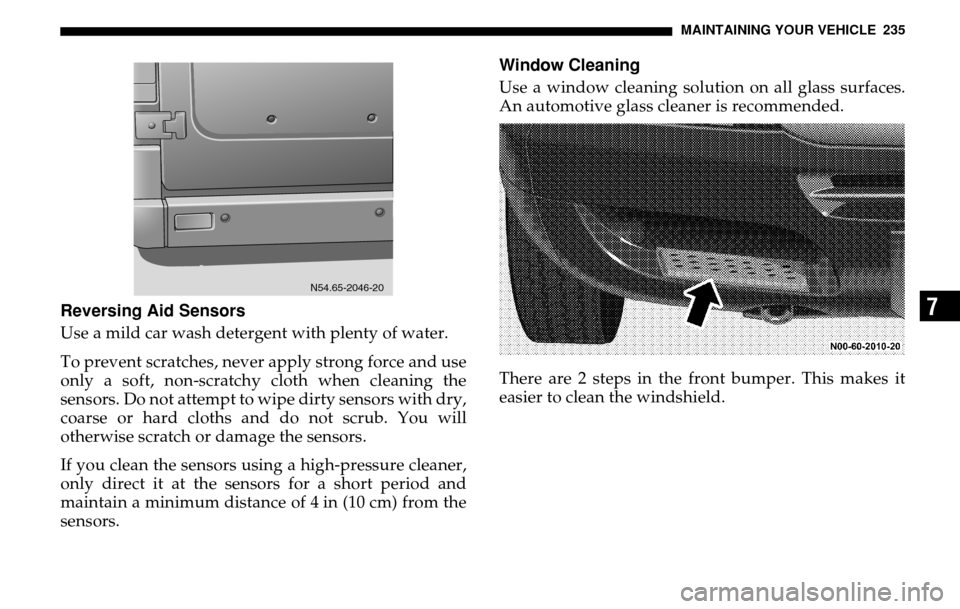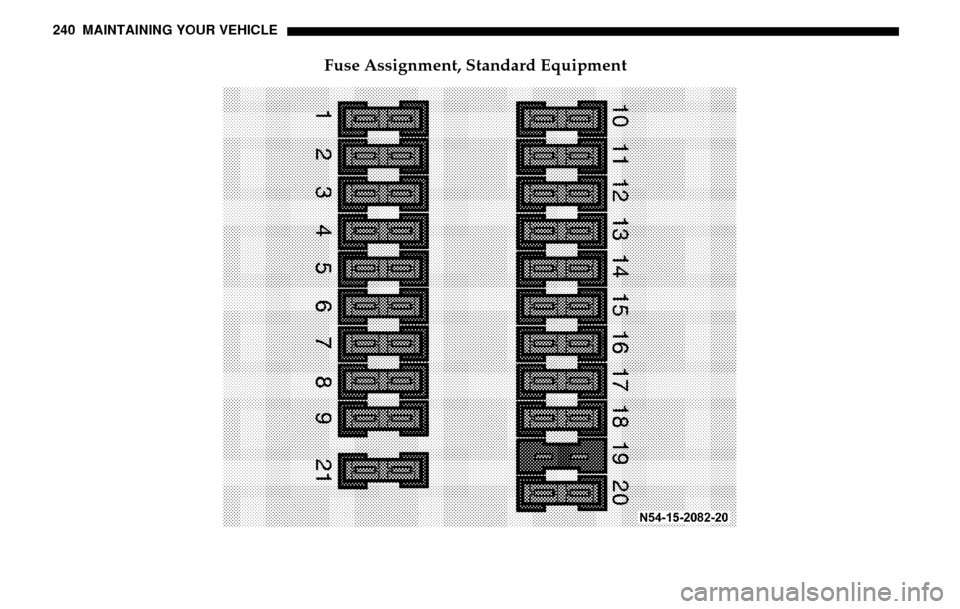DODGE SPRINTER 2005 1.G Owners Manual
Manufacturer: DODGE, Model Year: 2005, Model line: SPRINTER, Model: DODGE SPRINTER 2005 1.GPages: 288, PDF Size: 27.89 MB
Page 231 of 288

MAINTAINING YOUR VEHICLE 231
7
Appearance Care and Corrosion ProtectionIn operation, your vehicle is subjected to varying
external influences which, if gone unchecked, can
attack the paintwork as well as the underbody and
cause lasting damage.
Such damage is caused not only by extreme and
varying climatic conditions, but also by air pollution,
road salt, tar, gravel and stone chipping. Grease and
oil, fuel, coolant, brake flui d, bird droppings, insects, tree resins etc. should be removed immediately to
avoid paint damage. Frequent washing reduces and/
or eliminates the aggressiveness and potency of the
above adverse influences.
More frequent washings are necessary to deal with
unfavorable conditions; for example operation near the
ocean, in industrial areas (smoke, exhaust emissions),
or during the winter months.
You should check your vehicle from time to time for
stone chipping or other damage. Any damage should
be repaired as soon as possible to prevent the start of
corrosion.
In doing so, do not neglect the underside of the vehicle.
A prerequisite for a thorough check is a washing of the
underbody followed by a thorough inspection.
Damaged areas need to be undercoated again.
Your vehicle has been treated at the factory with a wax-
base rustproofing in the body cavities which will last
for the lifetime of the vehicle. Post-production
treatment is neither necessary nor recommended by
DaimlerChrysler Corporation.
WARNING!
Many cleaning products can be hazardous. Some
are poisonous, others are flammable. Always
keep cleaning products sealed and out of the
reach of children. Always follow the instructions
on the particular container. Always open your ve-
hicle’s doors or windows when cleaning the in-
side.
Never use fluids or solvents that are not designed
for cleaning your vehicle. Do not use fuel as a
cleaning agent. Fuel is flammable and constitutes
a health hazard.
Page 232 of 288

232 MAINTAINING YOUR VEHICLEBecause of the possibility of incompatibility between
materials used in the production process and others
applied later.
Scratches, corrosive deposits, corrosion or damage due
to negligent or incorrect care cannot always be
removed or repaired with car-care products. In such
cases it is best to seek aid by your authorized Sprinter
Dealer.
The following topics deal with the cleaning and care of
your vehicle and give important "how-to" information
as well as references to car-care products.
Power WasherWhen using a power washer for cleaning the vehicle
always observe manufacturers’ operating instructions.
WARNING!
Never use openings in the bodywork as steps.
You could otherwise damage the vehicle and it
could lead to an accident.
CAUTION!
Do not use abrasive or strong cleaning materials
such as steel wool or scouring powder, which will
scratch metal and painted surfaces.
CAUTION!
The intense jet of water of a round nozzle can
result in damage to the tire. Therefore never use a
round nozzle to power wash tires.
Always replace a damaged tire.
Always keep the jet of water moving across the
surface. To avoid damaging the vehicle, do not
aim the water jet directly at electrical components,
end of electrical lines, electrical connectors, intake
or ventilation openings, brake hoses, door joints,
seals, other rubber parts.
Page 233 of 288

MAINTAINING YOUR VEHICLE 233
7
Automatic Car WashIf the vehicle is very dirty, prewash it before you drive
into the car wash.
Fold in the exterior mirrors before washing the vehicle
in an automatic car wash and make sure that the
windshield wiper switch is in position 0.
The exterior mirrors and windshield wipers could
otherwise be damaged.
Make sure that mirrors are fully folded out after
leaving the automatic car wash.
Tar StainsQuickly remove tar stains before they dry and become
more difficult to remove. A tar remover is
recommended.Paintwork, Painted Body ComponentsPaint care should be applied when water drops on the
paint surface do not "bead up", normally every 3 to
5 months, depending on climate and washing
detergent used.
Paint cleaner should be applied if paint surface shows
signs of dirt embedding (i.e. loss of gloss).
Do not apply any of these products or wax if your
vehicle is parked in the sun or if the hood is still hot.
Use the appropriate paint stick for quick and
provisional repairs of minor paint damage (i.e., chips
from stones, vehicle doors etc.).Engine CleaningPrior to cleaning the engine compartment, make sure
to protect electrical components and connectors from
the intrusion of water and cleaning agents.
WARNING!
Smears impair visibility, which is impaired fur-
ther by unfavourable conditions (e.g. fog, dark-
ness, driving snow).
If a wax preservative is sprayed on after washing
the vehicle, wipe off the wax from the windshield
and the wiper blade rubbers. This will prevent
smears forming on the windshield.
Page 234 of 288

234 MAINTAINING YOUR VEHICLECorrosion protection, such as anticorrosion wax
should be applied to the engine compartment after
every engine cleaning. Before applying, all control
linkage bushings and joints should be lubricated. The
poly-V-belt and all pulleys should be protected from
any wax.Vehicle WashingDo not use hot water or wash your vehicle in direct
sunlight. Use only a mild car wash detergent.
Thoroughly spray the vehicle with a diffused jet of
water. Direct only a very weak spray towards the
ventilation intake. Use plenty of water and rinse the
sponge and chamois frequently.
Rinse with clear water and thoroughly wipe dry with a
chamois. Do not allow cleaning agents to dry on the
finish.
Due to the width of the vehicle, prior to running the
vehicle through an automatic car wash, fold back the
outside mirrors to prevent them from getting
damaged.
In the winter, thoroughly remove all traces of road salt
as soon as possible. When washing the underbody, do not forget to clean
the inner sides of the wheels.
Ornamental MoldingsFor regular cleaning and care of very dirty chrome-
plated parts, use a chrome cleaner.Headlamps, Taillamps, Identification Lamps, Turn
Signal LensesUse a mild car wash detergent with plenty of water.
To prevent scratches, never apply strong force and use
only a soft, non-scratchy cloth when cleaning the
lenses. Do not attempt to wipe dirty lenses with a dry
cloth or sponge.
WARNING!
Dirty or iced-up steps and entrances create a risk
of slipping or falling.
Keep steps, entrances and footwear free from dirt
(e.g. mud, clay, snow and ice).
Page 235 of 288

MAINTAINING YOUR VEHICLE 235
7
Reversing Aid SensorsUse a mild car wash detergent with plenty of water.
To prevent scratches, never apply strong force and use
only a soft, non-scratchy cloth when cleaning the
sensors. Do not attempt to wipe dirty sensors with dry,
coarse or hard cloths and do not scrub. You will
otherwise scratch or damage the sensors.
If you clean the sensors using a high-pressure cleaner,
only direct it at the sensors for a short period and
maintain a minimum distance of 4 in (10 cm) from the
sensors.
Window CleaningUse a window cleaning solution on all glass surfaces.
An automotive glass cleaner is recommended.
There are 2 steps in the front bumper. This makes it
easier to clean the windshield.
N54.65-2046-20
Page 236 of 288

236 MAINTAINING YOUR VEHICLEWiper BladeClean the wiper blade rubber with a clean cloth and
detergent solution.
Light Alloy WheelsA wheel care product should be used for regular
cleaning of the light alloy wheels.
If possible, clean wheels once a week, using a soft
bristle brush and a strong spray of water.
Follow instructions on container.
NOTE: Use only acid-free cleaning materials. The acid
could lead to corrosion.Instrument ClusterUse a gentle dishwashing detergent or mild detergent
for delicate fabrics as a washing solution. Wipe with a
cloth moistened in lukewarm solution. Do not use
scouring agents.Steering Wheel and Gear Selector LeverWipe with a damp cloth and dry thoroughly or clean
with a leather care product.
WARNING!
For safety reasons, remove key from ignition lock
before cleaning the windshield, otherwise the
wiper motor can suddenly turn on and cause in-
jury.
Dirty or iced-up steps create a risk of slipping or
falling. Do not use the step in the front bumper
when it is icy or dirty.
WARNING!
For safety reasons, remove key from ignition lock
before cleaning the wiper blade, otherwise the
wiper motor can suddenly turn on and cause se-
vere personal injuries and death.
Page 237 of 288

MAINTAINING YOUR VEHICLE 237
7
Cup HolderUse a gentle dishwashing detergent or mild detergent
for delicate fabrics as a washing solution. Wipe with a
cloth moistened in lukewarm solution. Do not use
scouring agents.Seat BeltsThe webbing must not be treated with chemical
cleaning agents. Use only clear, lukewarm water and
soap. Do not dry the webbing at temperatures above
176
°F (+80
°C) or in direct sunlight.
Headliner and Shelf Below Rear WindowClean with soft bristle brush, or use a dry-shampoo
cleaner in case of excessive dirt.
UpholsteryUsing aftermarket seat covers or wearing clothing that
have the tendency to give off coloring (e.g. when wet
etc.) may cause the upholstery to become permanently
discolored. By lining the seats with a proper
intermediate cover, contact discoloration will be
prevented.
Leather Upholstery
Wipe leather upholstery with a damp cloth and dry
thoroughly or clean with a leather care product.
Exercise particular care when cleaning perforated
leather as its underside should not become wet.
Cloth Upholstery
Clean with soft bristle brush, or use a dry-shampoo
cleaner in case of excessive dirt.
Tex Upholstery
Pour an interior care product onto soft lint-free cloth
and apply with light pressure.Hard Plastic Trim ItemsPour an interior care product onto soft lint-free cloth
and apply with light pressure.
WARNING!
Do not bleach or dye seat belts as this may severe-
ly weaken them. Due to this treatment they may
not be able to provide adequate protection. For ex-
ample, in a crash the belts can be torn.
Page 238 of 288

238 MAINTAINING YOUR VEHICLEPlastic and Rubber PartsDo not use oil or wax on these parts.
Do not use any caustic or alcohol-based or solvent-
based substances to clean plastic surfaces.
Avoid the use of stain removers, iodine tincture, nail
varnish and nail varnish remover, acetone, methylated
spirits, chlorine or ammonium-based cleaning agents,
cleaning agents containing abrasive substances.ELECTRICAL FUSESDamaged fuses are recognizable from their burnt-out
filament.
Prior to exchanging a fuse, turn the key in the ignition-
column lock to the 0 position and switch off the
consumer involved.
NOTE: Fuses must not be bridged. Replace fuses with
specified rated current. Only replace fuses when the
cause of the malfunction has been rectified.
NOTE: Fuses and relays (standard equipment) are on
the underside of the ignition column, refer to "Fuses
and Relays Standard Equipment". Fuses, relays and diodes (optional equipment) are
below the driver’s seat, refer to "Optional Fuse and
Relay Equipment".
CAUTION!
When replacing a blown fuse, it is important to
use only a fuse having the correct amperage
rating. The use of a fuse with a rating other than
indicated may result in a dangerous electrical
system overload. If a properly rated fuse
continues to blow, it indicates a problem in the
circuit that must be corrected.
Page 239 of 288

MAINTAINING YOUR VEHICLE 239
7
Standard Fuse and Relay Equipment1. Locked
2. Unlocked
3. Detent spring – engage when the cover is fitted Position of fuses and relays
4. Fuses
5. Relays
Page 240 of 288

240 MAINTAINING YOUR VEHICLE
Fuse Assignment, Standard Equipment